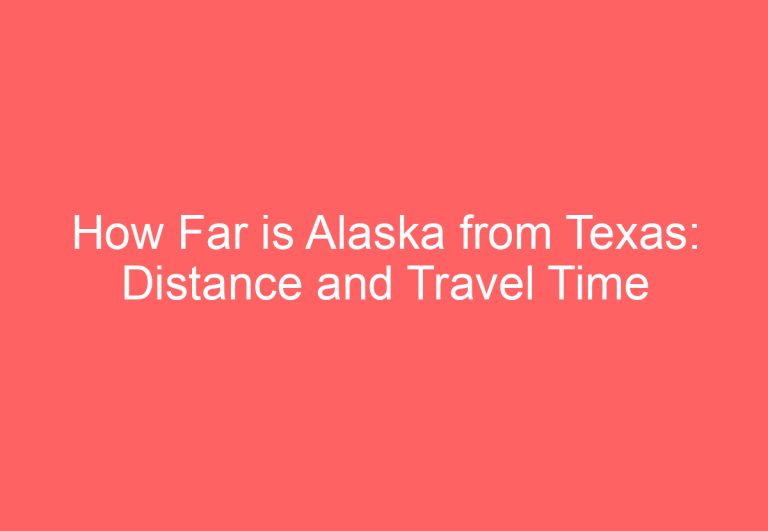Why Alaska is Not Part of Canada: A Clear Explanation
Alaska is a state located in the northwestern part of the United States. It is the largest state in the country and has a unique history that sets it apart from other states. One of the most interesting aspects of Alaska’s history is why it is not part of Canada.

Many people assume that Alaska should be part of Canada since it is geographically closer to Canada than to the United States. However, the reason why Alaska is not part of Canada is because the United States bought it from Russia in 1867 for $7.2 million. At the time, Russia was looking to sell Alaska and the United States was interested in expanding its territory. The purchase was controversial at the time, with many people questioning the value of the land and the high cost of the purchase. However, over time, Alaska has proven to be a valuable asset to the United States.
The history of Alaska’s acquisition by the United States is a fascinating story that involves politics, economics, and international relations. Understanding why Alaska is not part of Canada requires an understanding of this history. In this article, we will explore the reasons why Alaska is part of the United States and not Canada. We will examine the events that led up to the purchase of Alaska and the consequences of this decision. By the end of this article, you will have a better understanding of why Alaska is a state of the United States and not a province of Canada.
Historical Context of Alaska’s Ownership

Russian Exploration and Claim
The history of Alaska’s ownership dates back to the Russian Empire’s exploration of the region in the 1700s. Russian fur traders and explorers established settlements in the area, including the Aleutian Islands, Kodiak Island, and the Alaska Peninsula. The Russian-American Company, a state-sponsored enterprise, played a significant role in the fur trade and colonization of Alaska.
Competing Interests of Britain and the United States
In the early 19th century, the Russian Empire faced increasing pressure from the British Empire, which sought to expand its territorial claims in North America. The two empires were involved in several conflicts, including the Crimean War, which further strained their relations. The United States also had an interest in Alaska, as it sought to expand its territory and secure its western coast.
The Alaska Purchase and Its Global Influence
In 1867, Secretary of State William Seward negotiated the purchase of Alaska from the Russian Empire for $7.2 million. The purchase was initially met with skepticism and criticism, with some referring to Alaska as “Seward’s Folly.” However, the discovery of gold in the Klondike region in the late 1890s brought renewed interest and wealth to the area.
The Alaska Purchase had significant global implications, as it marked the end of Russian territorial claims in North America and strengthened the United States’ position as a world power. Today, Alaska Day is celebrated annually on October 18th to commemorate the transfer of ownership from Russia to the United States.
Overall, the historical context of Alaska’s ownership is complex and influenced by various factors, including the fur trade, competing imperial interests, and global politics. The Alaska Purchase remains a significant event in American history, shaping the country’s territorial expansion and global influence.
Geopolitical Boundaries and Disputes

Anglo-Russian Convention and Early Borders
The history of Alaska’s geopolitical boundaries is closely tied to the British Empire and Russia. In the early 19th century, Russia controlled the territory that is now Alaska, while the British Empire controlled Canada. The two superpowers were in a race to claim new territories around the world, and the Pacific Northwest was no exception.
In 1825, the British and Russian governments signed the Anglo-Russian Convention, which established the 54°40′ north latitude as the southern boundary of Russian America (Alaska). The boundary was later extended to the southern tip of Alaska in 1867 when the United States purchased the territory from Russia.
The Alaska Boundary Dispute and Resolution
The Alaska Boundary Dispute was a territorial dispute between the United States and Great Britain (which then controlled Canada’s foreign relations) over the boundary of southeastern Alaska and the coast of British Columbia. The disputed area, known as the Alaska Panhandle, is a complex coastal area consisting of large fjords and channel islands.
The dispute was resolved by an international tribunal in 1903. The tribunal, which was composed of six members (three from the United States and three from Great Britain), ruled in favor of the United States. The tribunal’s decision was based on the interpretation of the treaties between the United States, Great Britain, and Russia, as well as on the geography of the region.
The mixed tribunal was chaired by Lord Alverstone, who was appointed by the British government, and included Wilfrid Laurier, the Canadian Prime Minister, as a member. The tribunal’s decision was controversial, and it strained the Anglo-American relations at the time. However, it also marked the beginning of the Great Rapprochement between the two nations.
The resolution of the Alaska Boundary Dispute was a significant event in the history of the United States and Canada. It established the current border between Alaska and British Columbia, and it also marked the end of the era of territorial expansion in North America.
Frequently Asked Questions

What historical events led to Alaska becoming a US territory?
Alaska was initially a Russian territory, as it was part of the Russian Empire until 1867. The United States purchased Alaska from Russia for $7.2 million, which was a significant amount of money at the time. The purchase was made during the presidency of Andrew Johnson, and it was known as the Alaska Purchase.
How did the Alaska Purchase influence its national affiliation?
The Alaska Purchase was a significant event that led to Alaska becoming a US territory. It was a strategic move by the US government to expand its territory and gain access to the resources in Alaska. The purchase also helped to strengthen the US presence in the Pacific and prevented other foreign powers from gaining a foothold in Alaska.
What were the reasons behind Russia selling Alaska to the United States?
Russia sold Alaska to the United States for several reasons. One of the main reasons was financial. Russia was facing financial difficulties at the time, and the sale of Alaska helped to alleviate some of those financial pressures. Additionally, Russia was concerned about the possibility of losing Alaska to other foreign powers, particularly Great Britain.
What is the significance of the Alaska-Canada border?
The Alaska-Canada border is significant because it marks the boundary between the United States and Canada. The border was established in 1903 as a result of a treaty between the United States and Canada. The border is approximately 1,538 miles long and is the longest international border between two countries.
Has there ever been a movement for Alaska to join Canada?
There have been some movements in the past for Alaska to join Canada, but they have never gained significant traction. The majority of Alaskans identify as Americans, and there is little support for joining Canada.
What role did geography play in Alaska’s political status?
Geography played a significant role in Alaska’s political status. Alaska is located closer to Russia than to the United States, but it is separated from Russia by the Bering Strait. Additionally, Alaska shares a long border with Canada, which has led to close ties between the two countries. Despite its proximity to Russia and Canada, Alaska has remained a US territory due to historical, political, and economic factors.






